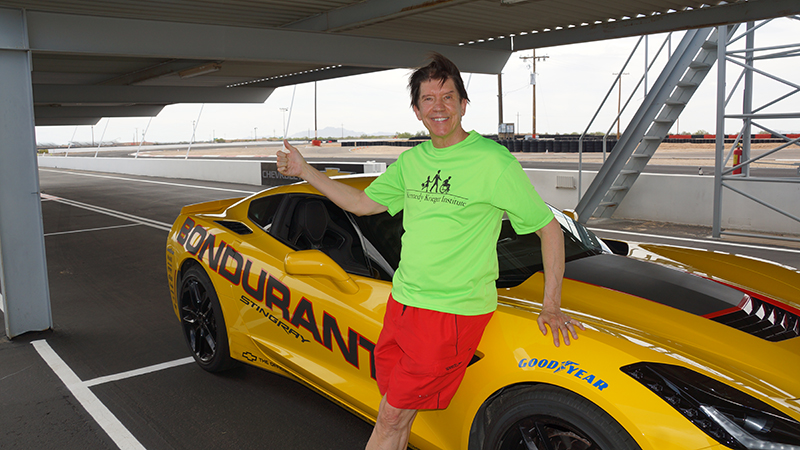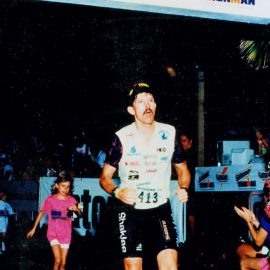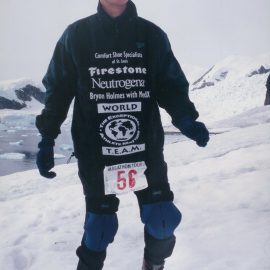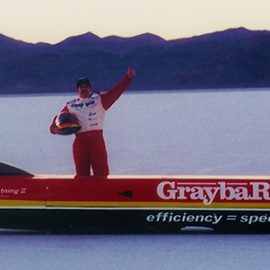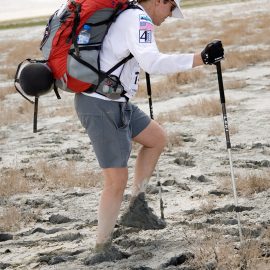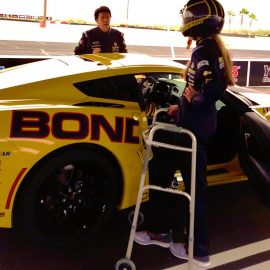Health & Wellness
Cameo: Patrick Rummerfield
We talk to Kennedy Krieger's Patrick Rummerfield, the world's first fully functioning quadriplegic.
Explain why your work is so personal. In 1974, I was in a high-speed car accident. My best friend was driving my car, and we hit the ditch doing 135 miles per hour. I went halfway through the windshield and came back at such a velocity that it sheared the seat off. I popped this eye [points to his right eye] out of its socket and lifted up part of my scalp. I had a wine bottle, a vintage-age Boone’s Farm apple—it’s a cheap wine—sitting between my legs. And when we first hit, I came down and that wine bottle was there and it popped this eye out. And then I went halfway through the windshield. So I broke just about everything in my body. I broke my neck in four places, C3, C4, C5, and C6.
What happened to your friend? He walked away with a chipped tooth. [Ed note: They remained friends until the friend died in a separate car accident about a year later.]
Wow. And you were a quadriplegic. Correct. Paralyzed from the neck down. When the accident first happened, I was given 72 hours to live. And then, 72 hours came and went and the doctors said, ‘We don’t know how you’re still alive . . . but the prognosis is still grim. You’ll be a quadriplegic, paralyzed from the neck down, for the rest of your life.” So they advised my dad to put me in a convalescent home to live out the remainder of my years. Here I am, 21, thinking, ‘Boy, I screwed up.’
At the time, they had just come out with the new prototype electric wheelchair that you could operate with your mouth. There was only one place—a place in Southern California—that was given the training. So I went to the rehab just to learn how to use the electric wheelchair.
One day, after quad-chair training, I was lying there daydreaming about playing basketball and racing Corvettes when my left big toe moved. Now, it didn’t move much. It was just a flicker. And then came the most excruciating pain. I started flopping around like a fish out water, screaming. They came in and they put me in a medical coma for, like, two-and-a-half days and then slowly brought me out. [When I woke up] I said, ‘What’s going on?’ And they said, ‘Well you just had real bad spasticity.’ I said, ‘No. I can move my toe.’ So [the doctor] grabs onto my toe and says, ‘Okay, move it.’ And then he goes, ‘Okay, well, I can feel something, but it’s not moving.’ But every night, I would concentrate. Every second that I was awake I was, ‘Move that toe, move that toe, move that toe.’ And then, finally, it got to where I could move it. The therapist would put a rubber band around it, and I would do weights with that rubber band. And the doctor came in and said, ‘What are you doing? You’re not only wasting your own time, you’re wasting the time of our therapists. What are you going to do with one big toe?’ And I said, ‘I don’t know, but someday I’ll have the world’s strongest left big toe and I’ll have a strong toe competitions to prove it.’
We just kept on, and then, in time, it went from my left big toe to all the toes in my left foot to all the toes in my right foot to my leg to my right leg. And then I started getting little flickers in my arms. Not my hands or my fingers, but in my arms. And then, in three-and-a-half years I got to where I could walk—not very far—dragging my right side. And then I’d lie down and take a nap! [Laughs]
Over the course of years, my hands and fingers started coming back. I’ve spent thousands and thousands of hours of rehab on my fingers to get them to where they’re at today.
Medically, how is a recovery like that possible?
When there’s a catastrophic spinal-cord injury the myelin protective/isolative sheets around the nerve tracks are damaged or die and the connections at the injury sight no longer function normally. Over time, what we’ve seen at the International Center for Spinal Cord Injury at Kennedy Krieger Institute, those participating in our Active Base Restoration Therapies (ABRT) re-myelin the damaged nerves and encourage new pathways. This greatly improves their ability to maximize their outcomes. I might be the first fully functional quadriplegic but, under the strong leadership and the ongoing development and implementation of new paralysis rehab modalities by our clinical director Dr. Cristina Sadowsky, I won’t be the last!
Is it true that you made a pact with God during your recovery? Absolutely. When I was in ICU and they said I only had 72 hours to live, I asked them to put my x-ray up over my bed. I would just lie there and pray, ‘Dear God, if you give me a second chance, I will do everything that I can to improve the lives of those who aren’t as fortunate as myself. All I want to do is to have a second chance.’ Ever since then, I’ve been doing everything I can to help as many people as I can. It might be something as simple as telling them, ‘You need to drink more water. You’re not drinking enough water, that’s why you have [urinary tract infections].’ If I need to help someone do a fundraiser to be able to afford equipment, I do that. Just whatever I can do to help. Sometimes just a little bit of encouragement from the right person—especially someone who has been there—can change a whole person’s life and outlook.
How did you get involved with Kennedy Krieger? [Former Kennedy Krieger director] Dr. John McDonald, [current clinical director] Dr. Cristina Sadowsky, and myself are part of the team who took care of Christopher Reeve. That started at Washington University School of Medicine in St. Louis. There was so much opportunity to come here and advance the program even further, so that’s what we did in 2004. We opened in June of 2005, and we’ve been going strong ever since.
Going back to your recovery, how would you characterize it? Slow. It took me 17 years to get to this level where I’m not falling down. At year 17, I mastered riding a bike without tipping over.
Before that, your big challenge was learning to run, right? I’d make it about three to five steps, and then I’d fall down. I’d get up, three to five steps, and fall down. It came to a point where my dad said, ‘Maybe you ought to forget about running. It’s been 16 years. Maybe it’s not going to happen.’ I was like, ‘Nah. I’m so close!’ He said, ‘You’re not close. Look at your elbows, look at all the scars on you from falling down. And a bike? Why would you ever want to get on something that goes that fast when you have no control? You could tip over any time.’
So what changed? I just kept on. One day, I was living in Sheridan, Wyoming, and the YMCA was exactly one mile from my house. My oldest daughter and I, every Saturday, after we got done with swim lessons, we would walk—she would run, she was an incredible little runner—home. So we took off jogging, and she’d turn around and run backwards. She said, ‘Jeez, dad, you’re doing pretty good, and I ran the whole mile without falling down.
Just all at once? Yeah, just bam. Two weeks before, I couldn’t do it. Suddenly, that connection was there.
Were you this tenacious before the accident? Yeah. From the time I was three until I was 7, I grew up in an orphanage. Those are very critical years. When you grow up in an orphanage, you fight for everything you have and you fight to keep whatever you have.
I was very athletic before the accident, so I just looked at rehab like if I hadn’t been in the accident I’d be working out anyway, so this is just kind of like my workout. I’d always say, ‘I know I’ve got to workout. So, let’s do it.’
Were there days when you were discouraged and didn’t want to do it? Oh, absolutely. Yeah. Everyone gets discouraged, at times.
Well, it seems like recovery is as much mental as it is physical. Oh it plays a huge part. You know, you choose to be sad. You either choose to be happy or you choose to be sad. And I’ve always been taught that you can accomplish a lot more if you’re happy in life. Your mental outlook is how you turn your dreams into goals and your goals into priorities.
I used to have what’s called My Victory Map, this map that went around my room so it was like, ‘Okay this is where I need to be. This is the one small step I need to get so I can do the next thing and the next thing. And you don’t have to spend a lot of time to achieve it. Even if you can only spend two or three minutes a day on that goal, eventually it adds up and you’ll achieve it.
What do you tell patients at Kennedy Krieger when they get frustrated with their progress? When you hit a plateau, certain individuals get depressed because they think, ‘Oh this is the end of it.’ Depression is a very serious disease and when you have it, you’ve got to A) know that you have it and B) seek help and C) you can’t give up. Because what people don’t understand is that everyone hits plateaus. Able-bodied people hit plateaus all the time. Olympic athletes constantly try to break out of that plateau. It’s normal. Especially when you have an injury or disease that causes paralysis. We’re no different than able-bodied people when it comes to working out. You’re going to hit that plateau. And when you do, you’ve just got to keep working because, like that Olympic athlete, all of a sudden, now they can take two or three seconds off their time. Bam. They’re off a going again.
Or they can suddenly run a mile. Exactly. That’s kind of how I’ve lived my life. You just don’t give up. Most people quit too soon. I mean, if they’d just hang in there, just a little bit longer, they’d be amazed at what they can achieve. And that’s not just here, that’s throughout life. That’s everything.
